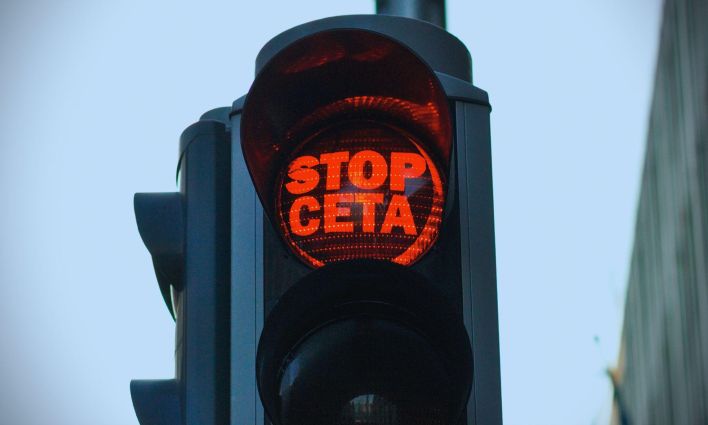After several years of far-right insurgencies in the United States—the Capitol riot on Jan. 6, 2021, and Trump’s return to public life—few expected Canada to be the location of the next great explosion of right-wing energy. And yet, this winter, people around the world watched as a series of protests and occupations—self-titled the “Freedom Convoy”—brought out long-haul truck drivers and others to ostensibly challenge the vaccine and COVID-19 mandates coming from the Canadian government. Despite being vaccinated at a rate exceeding 90%, some cross-border truck drivers were incensed at the vaccine requirements that the Trudeau administration had issued. This became a catch-all moment for anti-establishment right-wing activists to band together against Canada’s political consensus.
The protests were planned by figures well known on the Canadian far-right. They led to frightening incidents, like a giant spike in reported hate crimes and swastikas and Confederate flags appearing with some prominence. As trucks descended on Ottawa, and eventually other communities across Canada, counter-demonstrators also came together, outraged by the full-scale occupation of their communities taking place. While the Canadian government declaring a state of emergency has quelled many of these protests for the time being, the movement they started has spread around the world. Right-wing activists first took up the mantle in France, New Zealand and the United States.
Activists who want to protect their communities from far-right convoys can look to Canadian communities, who had a recent crash course in how to push back.
Occupying Ottawa
As the trucks headed into downtown Ottawa at the end of January, local organizer Dan Sawyer saw that these protesters were laying siege to people’s neighbour-hoods. Thousands had joined the anti-vaccine protesters and the diesel fumes were overwhelming people’s homes, making them nearly unlivable. At the same time, the occupiers were doing things like jamming the 911 emergency lines with calls, rendering the services unusable.
“The combination of the vehicles and the fact that they were so dug in at their encampment downtown made it seem really overwhelming,” Sawyer said, noting that the ability of the far-right demonstrators to interfere was heightened by the trucks clogging up their roads. The occupiers were themselves well-organized, creating a pathway to funnel in fuel and resources on a 24-hour timeline, essentially using a type of mutual aid to keep their protests going.
Community organizers looking to defend their city from a right-wing incursion were unprepared for a co-ordinated gathering of this size. But they soon launched mutual aid efforts of their own, helping people in the city who were unable to get normal resources. This included building on networks that had already existed and were exercised during the pandemic. Sawyer’s group, the Punch Up Collective, began supporting these efforts, as well as the planning for a large demonstration against the occupation. There was a small rally on February 5, but this was just a lead up to the much larger march that happened on February12, led by a series of community groups and public sector unions that coalesced into the new group Community Solidarity Ottawa (CSO).
“There was a really huge interest in doing something public, showing public opposition,” said Sam Hersh, an organizer with the municipal action group Horizon Ottawa, which joined the CSO coalition. “There was such a palpable air of anger and frustration in the city. There were people engaging in things like direct action that never would have happened.”
Many in town were scared to leave their homes, particularly given the reports of violence against marginalized people. “Strategically, the most important thing was to engage as many people as possible, so we chose a march route that would avoid the downtown occupation,” said James Hutt, an organizer with the Canadian Association of University Teachers who helped organize the mass march on February 12.
Together, CSO trained 50 marshals and prepared people for the mass demonstration, which drew a crowd of 4,000 participants, united by many of the same workers who were being impacted by the aggressive occupation. Unions were a key constituency, particularly given their resources. Instead of keeping messaging focused on vaccine mandates, they aimed to shift the conversation to real solutions for work-ing-class Canadians, such as paid sick leave, a living minimum wage and career protection for truckers.
The momentum from the large demonstration helped the groups to mobilize a community blockade the next day. Participants organized autonomously to prevent more right-wing supporters from entering the city and fortifying the occupation. “We had planned our blockade as a small affinity group comfortable with taking more direct action and the risks that comes with it,” Hutt said. “But to our surprise, residents were so fed up with the occupation and had been primed by the march, that affluent liberals with no organizing experience decided to do the same. We then decided to merge blockades with the one along the busier and more central road into town, setting up an additional blockade on the rear-end as well, effectively immobilizing the vehicles.”
Co-ordinating across three separate neighbourhoods, activists created barriers for supporters to actually enter the occupation area, artificially initiating a traffic jam that lasted hours. A caravan of right-wing convoy supporters calling themselves the “Blue Collar Convoy” was coming to bring resources to the central trucker convoy, so organizers needed to break that chain. They held the trucks back and only allowed the right-wing interlocutors to go if they gave up their signage, including any “hateful insignia” such as Confederate flags and fuel.
“The crowd wanted concessions from them,” Hersh said, noting that they wouldn’t allow the truckers to leave otherwise. Despite the convoy sending people in to provoke fights, local anti-racist activists had a team of de-escalators on the scene to help prevent violence. “It got to the point that there were a thousand people blocking this convoy,” Hersh added. “This was one of the most effective strategies and was an intervention that would have grown had the police not started arresting the convoy attendees.”
Organizers set up “red, yellow, and green” areas to designate which level of risk was likely to exist in each space, so protesters could make an informed decision on how they wanted to participate. “At the blockade, when we heard that fascists threatened to come attack us, we held assemblies to inform people of the risk and to check with those they came with about their comfort levels,” Hutt explained.
While many in the city wanted police to simply remove the convoy, organizers with a more abolitionist perspective offered up counter-narratives, pointing to the alleged complicity the police showed with the right-wing demonstrators. Many police were seen taking photos with protesters and described them as peaceful and friendly.
This ended up being one of the clearest strategic lessons: You will have to protect your own community. Many Ottawans expected that the police would be the ones to keep them safe from the encroaching far-right, but when they didn’t, community activists had to come together to fill the void. After “the first 10 days it became really clear…the cops weren’t coming to save us,” Sawyer said. “The cops put on the best display for why they need to be defunded that we’ve ever seen.”
the experiences in Canada show that community preparedness is important before a crisis explodes—both in responding to the far-right and to a wide range of other issues
Expanding to the rest of Canada
As the Freedom Convoy movement started to expand out of Ottawa, it hit smaller cities like Halifax. When convoy enthusiasts first rallied in Halifax on February 5, they were met by counter-protesters immediately. A bigger right-wing rally was planned for February 12, and local activists wanted to have a more co-ordinated response, rather than “wing it.” They began reaching out beyond their networks to local political organizations and pulled together promotional materials for a quickly organized rally.
“I tried really hard to de-emphasize issues of vaccination/COVID-19 restrictions that were being used, in my mind, as cynical ‘wedge’ issues, and to emphasize opposing the convoy as a political vehicle of the far-right,” said Brad Fougere, a Halifax resident who typically organizes with the radical labour union the Industrial Workers of the World. He and his fellow organizers faced debates from many corners about whether it would be better to simply ignore the far-right convoy supporters and deprive them of publicity. This ultimately had a negative effect on turnout.
“It really highlighted for me how unprepared we were locally,” Fougere said, adding that the hundred people they amassed still managed to show the convoy there was opposition, even if it wasn’t sizable enough to outnumber them. This is one of the key lessons they are taking away from the experience—and one they are offering to organizers in other cities now having to deal with the threat of a convoy occupation.
“Learn from what we did wrong: Start making plans now. Don’t wait and react,” Fougere said. “Push ‘anti-fascist’ organizations to do the work—wearing the label isn’t enough. Have up-to-the-minute, easily available updates during any events, in case people might be walking into a dangerous or heated situation. If possible, make plans to ensure that far-right propagandists are kept from getting a platform.”
In Winnipeg, the trucker protests showed up later and a response was started by the “pop-up” group Defend Winnipeg, which organized mutual aid and counter-demonstrations. When the convoy came in they had a similar effect on the city, despite being fewer in numbers. They used things like semi-trucks and tractors to block roads and make them appear larger than they were numerically. The counter-demonstration on February 12—the same day as those in Ottawa—brought together hundreds in a show of opposition, though they chose to keep a little distance from the truck occupation rather than directly confront them. "There were chants and there were a couple of speeches, but there was also a lot of crowd autonomy,” said James Walt, a local police abolitionist organizer who was at the demonstration. "It was a really important event, so people could show up in a space that was close but not necessarily clashing with it."
Like in Ottawa, Winnipeg protesters found that if they had been prepared in advance, they would have been in a better position. “These things really have to be anticipated and organized ahead of time,” Walt said, pointing out that you need labour, religious groups, feminist groups, 2SLGBTQQIA+ organizations and others to come together in a common front against the far-right. “Just because they are gone now, we can’t just step back and assume that this kind of thing won’t happen again.” They also offered an abolitionist perspective, since many people simply wanted more police to intervene in the protests. This was despite the fact that the police had been far more hands-off with the far-right protesters compared to the left-wing and Indigenous counter- demonstrators (two of whom were arrested for what protesters allege was briefly standing in front of a truck).
Other cities around Canada have followed suit. In Kingston, Ont., the convoy was reportedly “thwarted” by protesters and health-care workers who, after converging on city hall, blockaded the road, arm in arm, to stop the convoy from getting in. In Vancouver, the convoy was met immediately by counter-demonstrators who wanted to let protestors know they were “not welcome” and that Vancouver residents “support our health-care workers.” This included road blockades to stop the incoming convoy and demonstrations at the regional hospital.
As these convoys build up steam in the U.S., the experiences in Canada show that community preparedness is important before a crisis explodes—both in responding to the far-right and to a wide range of other issues. In Ottawa, the CSO coalition is now continuing their work, having since organized a march to demand continued COVID-19 protections, accountability from government officials who they say allowed the occupation, and opposition to white supremacy and all forms of oppression. “[This has] showed people the real importance of direct action,” Hersh said. “Not only reacting when this sort of thing is happening, but also the longer-term thing of building an anti-fascist movement.”
The lessons from the blockades that prevented the far-right from entering Canadian cities are particularly useful because, once they arrive, it’s difficult to get them to leave. Strategically, organizers also saw that planning routes around the specific layout of the city and figuring out which days of the occupation had the lowest numbers gave them an edge when it came to effectively blocking efforts to resupply the occupiers. Such efforts can choke off far-right caravans and undermine their longevity. “Map out which roads they’ll take and where the choke points are. It only takes a couple dozen people and a few bicycles to render their vehicles useless. And if they’re deterred for [six] hours or a day, it will undermine their entire [operation],” Hutt said, who also notes that having safety plans are critical given the far-right’s penchant for violence. By building up more long-term infrastructure, both for mutual aid and for defence, communities have the resources to respond quickly and with precision when something so seemingly sudden occurs. “If they say they are coming to your city and don’t plan on leaving, take them at their word,” Sawyer warned. As these convoys potentially grow, it will be on existing groups in each city to figure out how to keep residents safe and to show displeasure for how anti-vaccine groups have tried to hijack working-class angst.
This article was originally published by Waging Nonviolence. It has been edited for length and clarity and is republished under the Creative Commons Attribution 4.0 International License.








